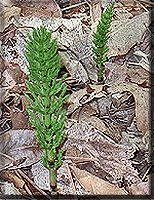

Equisetum arvense


Equisetum arvense
Origin - Europe
Part of the plant used - Herb (overground part)
Edible Parts A bushy native, perennial, rhizomatous horsetail. Highly variable. Sterile stems jointed (joints about 1" long and 1/24" - 1/16" in diameter), hollow, six to nineteen grooved, usually erect, bearing up to 20 whorls of slender branches, 2"-24" tall and terminating in a long, naked point. Leaves scalelike, deciduous, inconspicuous, in whorls at the nodes; are connected at their bases. Fertile stems short, succulent, yellowish, ephemeral shoots with only two to five joints, generally 2"-12" tall, that appear early in the growing season. The green, sterile shoots develop later, by which time the fertile shoots usually have wilted. Unique among our Horsetails, this fertile stem never turns green.
Pharmacology::
The essential element, silicon, is present in very large amounts in horsetail grass. The element is present in the plant in its organic forms, silicon dioxide (SiO2) or silicic acid/silicate (Si(OH)2). Silica is essential for growth and healing, being a major constituent of bones, cartilage, connective tissue and skin. In the body silica makes up part of the mucopolysaccharides (glycosaminoglycans) which play critical structural roles in bone and cartilage. The degeneration of tissues with age corresponds with decreasing levels of silica in the tissue. Silicic acid also stimulates an increase in white blood cells, helping to increase resistance to infection. In the past a tea of horsetail grass was frequently given to tuberculosis patients. The second major class of ingredients of horsetail grass is the saponin. These compounds have a mild diuretic effect. Horsetail is widely used for genitourinary problems including inflammations, kidney stones, enuresis, lithiasis, nephritis, gout and prostate problems.
Active Properties:
Besides the wound healing, connective tissue strengthening, and genitourinary properties, horsetail grass also possesses styptic properties, helping to heal bleeding ulcers. The plant has been used for arthritis and atherosclerosis since both joint and arterial tissue are rich in silica.
Toxicity, Cautions & Contraindications
No known toxic effect for normal use. Avoid use with antihypertensive drugs, digitalis, (corticosteroids or corticosteroid), heparin and lithium.
Historical Uses: